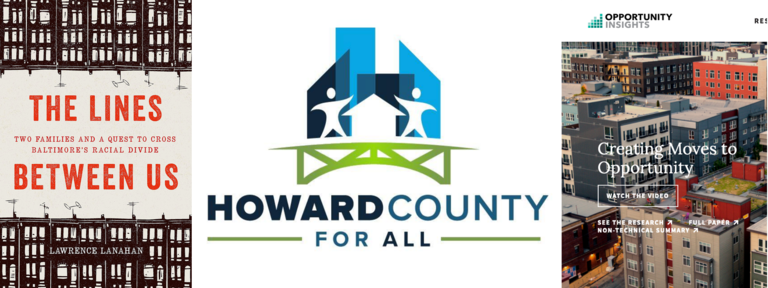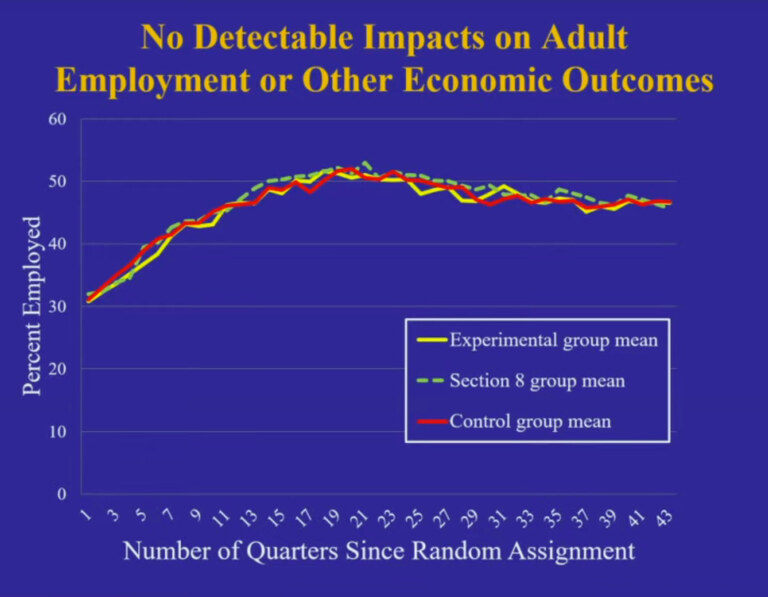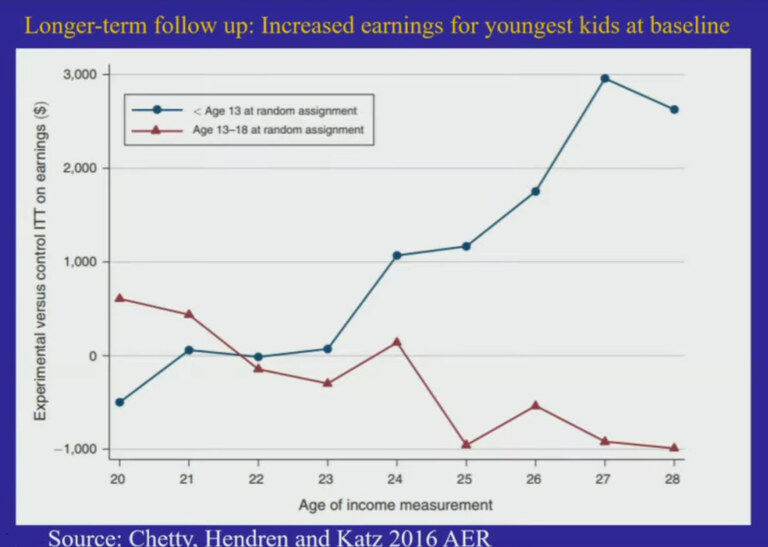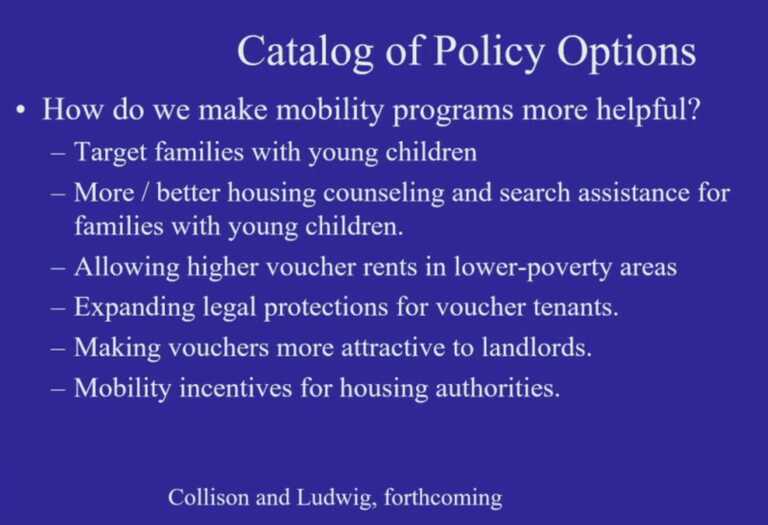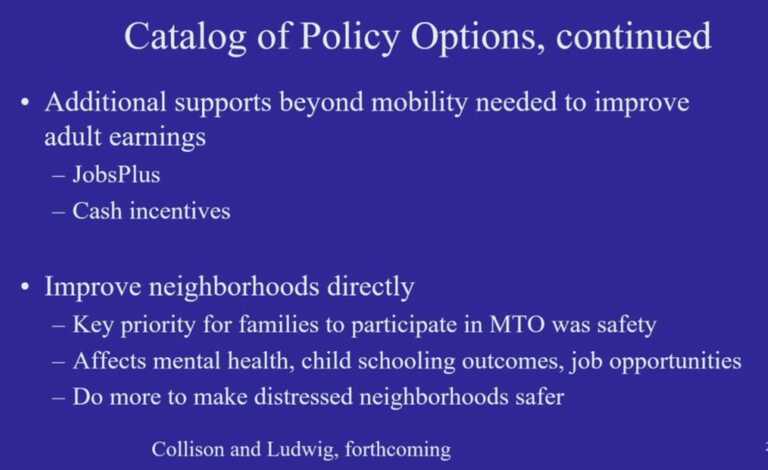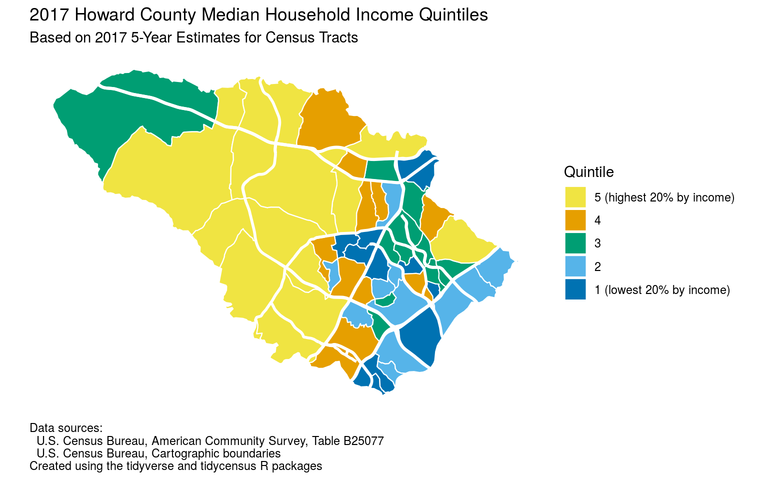UPDATE 2024/01/04: This post originally appeared on my Civility and Truth Substack newsletter. I’ve moved it to my main site in an effort to collect all of my writing in one place.
Should we in Howard County be encouraging more people to move here, especially people with lower incomes who hail from Baltimore city and elsewhere? Should we instead be focusing instead on the people left behind in areas with high rates of poverty, helping them where they live now? And the most basic question: Who is Howard County really for?
Recently I attended, read, and watched three things bearing on those questions: the initial meeting of the local Howard County for All advocacy group, the book The Lines Between Us: Two Families and a Quest to Cross Baltimore’s Racial Divide by local journalist Lawrence Lanahan, and an event on “Moving to opportunity: What’s next?” put on by the Brookings Institution, a DC think tank.
Howard County for All was recently founded and/or promoted by a number of local activists, including former local blogger T.J. Mayotte and Elevate Maryland co-hosts Candace Dodson Reed (who moderated the September 12 launch event) and Tom Coale. Its statement of purpose claims that “Howard County should be open to all,” that the county is “strengthened through inclusivity,” and in support of those values should “create and maintain a variety of housing options alongside a commitment to long-term affordability.”
In The Lines Between Us, Lanahan (who spoke at the Howard County for All launch event) weaves together the stories of three people: Mark Lange, who with his wife Betty was called by his Christian faith to move from their Harford County suburb to live in Baltimore’s Sandtown neighborhood; Nicole Smith, who moved herself and her young son from Baltimore City to Columbia with the help of a special housing voucher; and Barbara Samuels, a lawyer and activist who participated in the legal battles to open up affordable housing across the entire Baltimore metro area.
Finally, the Brookings event, broadcast over the Internet, featured presentations and discussions of research on the benefits to families moving from high-poverty areas to low-poverty areas, and whether and how government policies should promote this.
Since my writing tends to be data-focused I’ll spend most of my time discussing the Brookings event, and in particular the presentation on the Moving to Opportunity initiative, with occasional asides regarding the human impacts documented in Lanahan’s book and the ongoing controversies involving affordable housing and school redistricting in Howard County. Since the Brookings event, Lanahan’s book, and the Howard County for All group all are coming at these issues from a progressive/liberal point of view, I’ll also try to acknowledge conservative and libertarian perspectives as well.
As noted in the slide above (taken from the Brookings webcast, as are the other slides below), Moving to Opportunity was a Federal initiative to determine what would be the benefits (if any) of providing government assistance to help families with children move from high-poverty neighborhoods in central cities to low-poverty areas in the surrounding suburbs.
Stated this way the MTO project could be portrayed as a classic attempt at social engineering undertaken by central planners blind to social and economic realities. However, it could also be seen as an attempt to overcome the ill effects of previous social engineering by central planners with different priorities. Lawrence Lanahan devotes much space in his book to documenting government policies that had the effect of advantaging (mostly white) suburban dwellers at the expense of (mostly black) city dwellers, including radically changing the face of cities by destroying traditional neighborhoods in the name of “urban renewal.”
Some of these activities are in the past, but others are live issues today, most notably with respect to zoning. In effect zoning laws employ government coercion to restrict the freedom of property owners to make what might be more productive uses of their land. For example, a landowner might be allowed to build a large single-family home, but be prohibited from building a duplex, an accessory apartment, or a small apartment complex, even though these alternatives might be more lucrative for them and better address market demand.
In the past many Maryland counties, including Baltimore County in particular, went even further and specifically denied approvals for any attempts to build “affordable housing” projects, even when they otherwise conformed to zoning requirements. They were supported in this by politicians and homeowners who agitated against poor inner-city residents moving to the suburbs. As but one example, when 285 families from Baltimore public housing were chosen to receive special housing vouchers as part of the Moving to Opportunity initiative, opponents portrayed it as the first step in moving thousands of poor Baltimore city residents into eastern Baltimore County, displacing existing residents.
Given the role of past government policy in isolating poor people and their housing from the rest of society, it’s understandable that some government officials would look for a way to try to remedy the effects of those policies by providing lower-income families opportunities to move to more mixed-income environments. But leaving aside the political controversies, did this actually result in any benefits for such families?
The Moving to Opportunity initiative came in the wake of other small-scale experiments that suggested that there were major benefits to lower-income families moving to the suburbs. The results from the MTO initiative itself were more measured, and the initial presentation at the Brookings event was essentially a recap of why the MTO results were worse than those from prior initiatives, and what the best case results might be.
Leading with something positive, there were apparently some benefits related to the physical and mental health of those lower-income adults who moved with their families to the suburbs, including in particular lower incidences of depression and diabetes. Even though these benefits appear to be somewhat modest, they could both improve quality of life for the people involved and help lessen government health care spending on these chronic diseases.
Exactly why did the adult MTO participants have health improvements? The speaker at the Brookings event was silent on that point, but I’ll speculate that it may have been associated with reduced stress. (More on that point below.)
However, even though moving to the suburbs may have improved the health of lower-income adults, it ultimately didn’t make any real difference to their economic prospects. The graph above tells the tale: the percentage of lower-income adults employed ended up being the same no matter whether they moved to the suburbs as part of the MTO initiative (“experimental group mean”), moved elsewhere in the city through the normal Section 8 housing voucher program (“Section 8 group mean”), or stayed where they were (“control group mean”).
Even for those employed it’s not clear that moving to the suburbs led to better-paying jobs. For example, as described in The Lines Between Us, upon moving to Columbia Nicole Smith was able to complete an associate degree at Howard Community College and work as a child care provider. While she was able to support herself and her son, in the end she did the same type of work her mother did, just in a different setting.
What’s the explanation for the failure of the MTO initiative to change these life outcomes? My own personal theory goes somewhat as follows: We can view people as having both natural talents and certain personality attributes (e.g., being conscientious or extroverted) that suit them for certain types of work. These talents and these personality attributes are in turn partly inborn and partly developed through people’s unique life experiences in their early years.
For example, the child who is naturally good with their hands can develop related skills (for example, as an carpenter or auto mechanic) if given the opportunity to do so. A child who is naturally extroverted may find that they can stand out from their peers by emphasizing their ease and skill in public settings, and perhaps end up in sales or politics. And so on.
But once they have become adults people have mostly developed whatever natural talents they possess, and their personalities are pretty much fully-formed. Based on their talents and personalities there are some jobs for which they are well-suited, and some jobs in which they would likely never succeed. (For example, though I’ve worked in sales environments for most of my career I know that my personality is ill-suited for life as a salesperson.) Where one might move might affect this somewhat at the margins, but is unlikely to make a major difference.
A conservative could here point to Thomas Sowell’s “constrained vision”: that human nature puts limits on what society and especially government can accomplish in alleviating human suffering and promoting human flourishing. Of course one could also go on to point out that everyone is equal in the sight of God, and that a well-ordered society can and should provide opportunities for every person to live a life of dignity and worth within the scope of whatever talents and other attributes they possess.
For us to do otherwise, to seek to close ourselves off from those less fortunate by birth and circumstance, and to countenance their isolation out of sight and mind, would be like attending a church whose doors are open only to the conspicuously righteous. According to The Lines Between Us it was the struggle to reconcile their comfortable suburban lives with their felt duties as followers of Christ that led Mark and Betty Lange to leave the suburbs for life in Baltimore city. For those of us who choose to stay in the suburbs it may also serve as motivation to welcome those from the city who wish to move here, and to assist them in doing so.
It’s also worth noting here what the MTO results do and not mean: They imply that if a random person from a low-income neighborhood moved to a higher-income neighborhood it would make little or no difference to their employment prospects. But in real life the people who move from lower- to higher-income neighborhoods do not do so at random. Given the financial and other barriers to moving, the lower-income people who do move are those who are most motivated to make the move, and most motivated to make for themselves a successful life in their new neighborhoods.
(Incidentally, this is exactly why small-scale programs prior to MTO showed such good results, because they had a “selection bias” of this type. The random assignments in the MTO program removed the effort of this bias.)
The discussion above was with reference to lower-income adults moving to the suburbs. What about their children? Here the picture is more complicated: all things equal, those children who moved to the suburbs as part of the MTO initiative as young children had increased incomes later in life compared to those who stayed where they were, while those who moved as teenagers did not. (The differences in income shown in the graph may seem small, but the cumulative differences in lifetime earnings could be quite large.)
What could account for these different outcomes? To go back to my hypothesis above, I presume that natural talents in children can be enhanced by opportunities they have to discover what they like doing and get better at it, and that personality development and socialization in children are strongly influenced by the environment outside the home, including both their peers at school and play and the overall influence of neighborhood adults. (See for example my post on the ideas of Judith Rich Harris.)
Children who moved as youngsters would then have more opportunities to develop their inborn talents and a longer period of socialization to prevailing norms. They would be analogous to the young children of immigrants, who may have begun life speaking a different language but then learn to speak a new one fluently. On the other hand, children who moved as teenagers would already be well on the way to full development of their talents and personalities, and the new environment would likely have less effect on them. They would be like immigrants who arrive as older teenagers or young adults, who may learn a new language but still speak with an accent.
The speaker at the Brookings event then went on, as speakers at such events typically do, to discuss implications for policy, in this case various options for improving the effectiveness of programs that encourage lower-income families to move to higher-income neighborhoods. The most obvious of these is to focus on families with young children, for reasons discussed above. The others you can read on the slide, but I’ll recap them briefly: provide additional counseling, allow for higher rents, and work with tenants, landlords, and housing authorities to improve the experiences of these families and make it more beneficial to rent to them.
(You can find more information about these recommendations in the article “Neighborhoods matter for opportunity: Time for more place-conscious policy” on the Brookings web site, the “Collinson and Ludwig, forthcoming” article referenced on the slide.)
Of course, this assumes that moving families is the best way to approach this problem. The alternative approach, again as outlined by the speaker, is to try to improve high-poverty neighborhoods directly. Here the key insight was that families participating in the MTO experiment wanted to move in large part because they felt unsafe living where they were, and wanted to escape those neighborhoods for those in which they could be more secure.
This harks back to my discussion in an earlier post about the importance of reducing crime in the context of promoting racial equality, and to do so in a way that (as I wrote later) “both protects and respects” the people living in these neighborhoods.
Let’s bring this back to Howard County. The county has replicated in miniature the income and housing patterns of the larger Baltimore metro area, with a relatively low-income high-density core almost encircled by relatively high-income low-density areas. Here Columbia plays the role of Baltimore city and western Howard the role of Baltimore County and other suburban jurisdictions. What, if anything, should we try to do about the resulting patterns of segregation?
This question is at the heart of the ongoing controversies in Howard County over development, affordable housing, and school redistricting. I can’t offer a definitive answer to the question, but I see at least three possible paths for the county:
The first is simply to maintain the status quo: Let existing patterns of segregation remain roughly the same, but at the same time make some moves toward maintaining affordability of housing in select areas of the county, typically in and around Columbia.
The second takes us down a path similar to that traveled by Silicon Valley and other high-tech meccas we often wish to emulate: In this scenario the problem of school overcrowding would be addressed by limiting development as much as possible (with possible exceptions for senior living projects). With development brought to a near halt, prices for existing housing would soar as demand for Howard County’s “good schools” and quality of life remained high.
Political pressure would then rise for existing homeowners to be protected against tax increases, and for the burden of paying for new schools and other new county services to be put on new residents as much as possible. The result would be to price out low-income or even moderate-income families. The adults in such families would still be needed to fill a wide range of jobs in Howard County, but they would have to commute in from other places and then leave the county at the end of the day.
The third scenario would see more aggressive efforts to reduce residential segregation and make Howard County more affordable to anyone wishing to live here. This might include school redistricting along the lines of the proposed plan, an expanded program of school construction to get ahead of demand for housing, and placing affordable housing projects in areas outside of Columbia. It might also include encouraging more development in selected areas in west Howard, for example along commuter routes like I-70 and MD 32, and extending county services into those areas as necessary to support higher-density housing.
Which path we take depends on the values we each think are most important, and the political power we can bring to bear in coalition with others. My own inclination is for us to pursue the path of making Howard County a county that as much as possible is open to all who aspire to live here, not one populated by a monoculture of highly-educated high earners singularly obsessed with home values and test scores. That reflects the values I hold, and is why I support the efforts of groups like Howard County for All.
As always, if you find these posts interesting and useful please tell other people about them and encourage them to subscribe to the Civility and Truth mailing list. Having readers who care enough to subscribe helps motivate me to send these posts out on a regular basis, and the more readers I have the more motivated I’ll be. In the meantime, thanks for reading this post!
